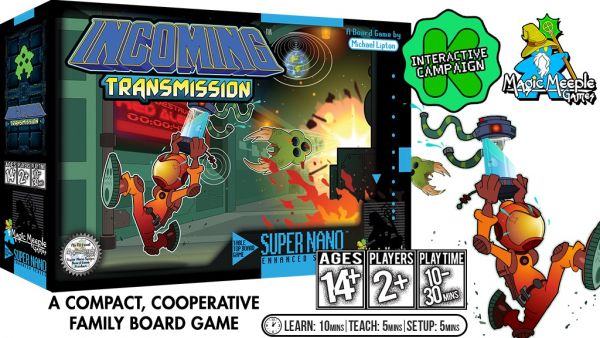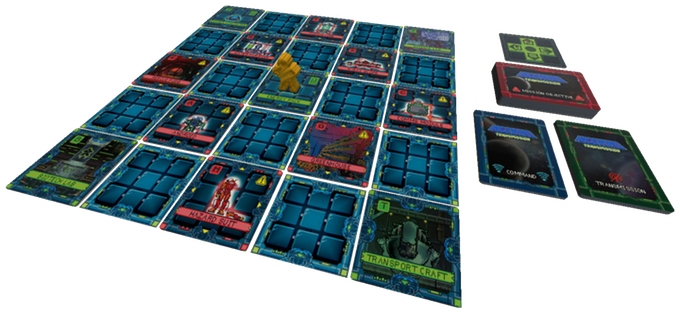Incoming Transmission: Can You Decipher the Commands and Save the Mission?

One lone cadet survives on a space station. Mission Control is the only hope for escape, but communication is malfunctioning. Will the cadet be able to decipher what Mission Control is saying?
Incoming Transmission is an asymmetrical cooperative board game, currently on Kickstarter. With only five cards each round, one player must communicate to the others what actions they need to perform on the station in order to survive, but with a garbled communication system, it may not be as simple as it sounds.
Gameplay
One player takes on the role of Mission Control and all other players will control the cadet on the board. The board is made up of a series of tiles: twelve empty hall tiles and thirteen module tiles. Five of the modules begin the game repaired while the others all start the game broken. Modules come in two categories: stations (which cannot be moved) and devices (which once repaired the cadet can pick up, carry around, and drop).
Each game of Incoming Transmission takes place over seven rounds. Mission Control draws three mission cards at the start of the game. Mission Control is the only player who can look at these cards. Each mission involves moving one specific module adjacent to another specific module and both being repaired.
Mission Control has a deck of command cards. The cards include move one space up, down, left, and right; repair, pick up module, and drop module. Every round, Control selects five of these command cards. These will be instructions for the cadet on the game board. Before handing the cards to the cadet players, a transmission card is drawn. A transmission card can show a clear signal in one of five card spaces. So, for example, if the clear signal is in the third slot, Mission Control will hand the cadet the card she wishes him to perform third. Or, the transmission card can also contain an error, in which case Mission Control adds a random sixth command card and the cadet will have to choose one of the six cards they are given to ignore. Finally, a transmission card can have neither a clear signal nor an error message.
After the transmission card is resolved, Mission Control shuffles any cards not affected by a clear signal and hands them to the cadet. The players in control of the cadet must then look at the cards and try to deduce in what order Mission Control intended the card actions to be executed. Mission Control may not communicate or give hints in any way, but all players in control of the cadet may discuss their decision.
If at any point during the round a mission is complete, even if the necessary module tiles move away from each other later in the same turn, Mission Control announces a complete mission and a signal boost card is drawn. These are one time use special cards that make things easier for the Cadet (they include things like acting as a clear signal or removing a command card introduced by an error).
Players win the game if they complete all three missions in seven rounds, otherwise they lose the game.

Review
Incoming Transmission offers a fascinating puzzle, forcing both sides to try and get inside each other’s heads. Both roles pose their own challenges and are therefore both satisfying and fun to play.
As Mission Control you have to think through various scenarios of how players might interpret the cards you give them, while the transmission cards ensure that you can never be one hundred percent confident, as they often throw an unexpected spoke in your wheel. And of course, it’s always enjoyable to be the one player in the game who knows all the answers.
As cadet, it’s fun to talk things through with your teammates (though the role is also enjoyable solo) and as a cadet you get to have the most fun with deduction and playing the odds. Sometimes you’re just going to have to make a guess and you have to try to figure things out if your guess is wrong, which is going to potentially lose you more time to correct.
While the game is intended for two or more players, and playing the cadet as a team is fun, a smaller group is better. Too many players controlling the cadet would find it difficult to contribute to the game equally.
There are a ton of mission cards included (sixty-eight are planned) and multiple transmission cards which you can use to adjust the difficulty of the game. Given that and the randomness of the board setup, you’re always going to have a game that’s a little different each time you play.
Incoming Transmission is a satisfying puzzle. It’s one of those games that, after playing the first time, we were eager to play again to learn the best strategies and how to best communicate with and use the command cards. If you enjoy deduction and puzzles, check it out on Kickstarter.
Pros: Both sides are enjoyable to play, great puzzle and deduction mechanics
Cons: Not at its best with a larger group
Disclosure: this preview is based on our evaluation of an unpublished prototype of the game, which is subject to change prior to publication. While a modest payment was received to expedite the review process, our thoughts and opinions expressed here are honest and accurate.









